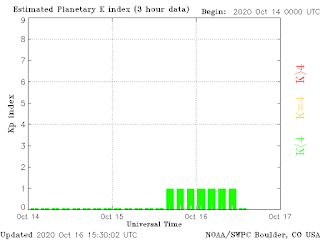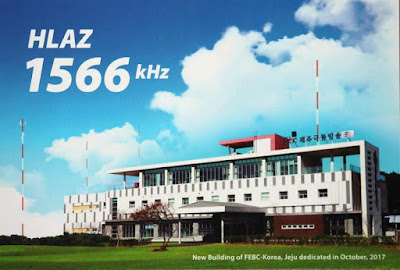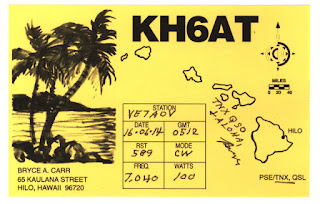Posts Tagged ‘power line noise’
 BCB DX + A (Possibly) Quieter Receive Antenna
BCB DX + A (Possibly) Quieter Receive Antenna
The earlier very quiet geomagnetic field has produced some amazing propagation on the AM Broadcast Band for west coast DXers. Where local blowtorches don't splatter the band, the past few nights have produced audible signals from several European countries while the mornings are filled with Asians and signals from Alaska ... yes, on the AM Broadcast Band!
The morning of October 11th was particularly good here, with 9 different stations in Alaska heard. Listen and see if you can hear the identification at the top of the hour (7 AM my time):
780 KNOM Nome https://qsl.net/ve7sl/knom.mp3
670 KDLG Dillingham https://qsl.net/ve7sl/kdlg.mp3
700 KBYR Anchorage https://qsl.net/ve7sl/kbyr.mp3
680 KBRW Barrow https://qsl.net/ve7sl/kbrw.mp3
890 KBBI Homer https://qsl.net/ve7sl/kbbi.mp3
This is a short clip from HLAZ, Far East Broadcasting Company, with their 'Radio Liangyou' program in Japanese. HLAZ is located in Jeju, South Korea. They will also respond to reception reports with a nice card ... sadly a growing rarity with AM broadcasters nowadays.
These were received using my Perseus SDR and 10' x 20' active loop pointed to the NW.
Hopefully these nice conditions will continue for some time but on the other hand, I'd like to see the Sun ramp-up its sunspot production as fast as it can, which would likely put a damper on these quiet conditions. (post edit: and that's exactly what happened!)
An interesting antenna that may help overcome their noise issues is described by KK5JY on his website here.
It looks simple enough to deploy and try to see if it overcomes your local noise issues. Those with underground utilities however, may find that it makes the noise worse.
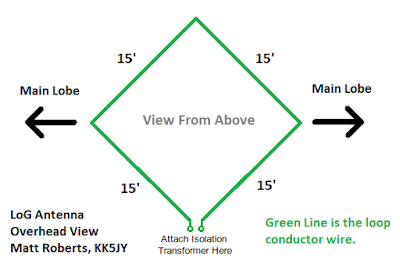 |
| courtesy: kk5jy.net |
 Trouble Free HF Antenna For The Apartment Dwelling Ham
Trouble Free HF Antenna For The Apartment Dwelling Ham
 Unfortunately we all know of or hear about hams that have given up all hope of getting on the air, once moving into an apartment or condo, where antennas are normally prohibited. One enterprising local amateur has combined early established antenna fundamentals along with sound engineering, to arrive at an elegant and highly successful solution. If you are also a 'location challenged' amateur, it may just be the thing that will help you, and others, take back your hobby and get on the air!
Unfortunately we all know of or hear about hams that have given up all hope of getting on the air, once moving into an apartment or condo, where antennas are normally prohibited. One enterprising local amateur has combined early established antenna fundamentals along with sound engineering, to arrive at an elegant and highly successful solution. If you are also a 'location challenged' amateur, it may just be the thing that will help you, and others, take back your hobby and get on the air!John, VE7AOV, has been operating from his apartment, in the heart of the very large and noisy greater Vancouver, for several years now ... not simply 'operating', but thriving, from his cozy fourth-floor apartment radio station. The wallpaper shown below would not usually be expected to grace the shack walls where antennas are not permitted!
It's soon apparent that John has also overcome the usual problem of noise ingression, from every appliance and random RFI generator in the complex. This is no lucky fluke but all by design, and delivered via an all but invisible classic antenna system made of #26 wire and a few Starbuck's stir-sticks!
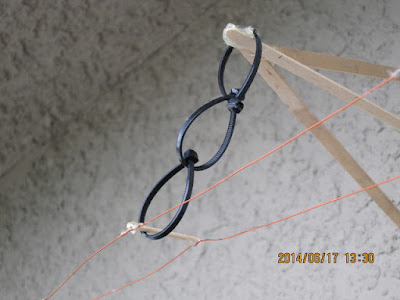 |
| 600 ohm #26 balanced line |
I'll let John tell you a bit more before sending you to his fascinating website, Intuitive Electronics, where you can learn more about his system and the engineering behind his successful, low-noise installation.
When it comes to a high frequency ham station, the antenna alternative chosen by most apartment dwellers is no antenna at all. The design here is a wisp of an antenna that bothers no one and which can work Japan, Australia, France, European and Asian Russia, the Caribbean, Central America, Polynesia and South America from the Pacific coast of Canada. It is a simple solution for apartment dwellers, it is a cheap solution and it causes no t.v.i. or other r.f. problems. It is far preferable to the alternative selected by so many fellow apartment dwellers: no antenna at all.
An implication that it seems to be impossible to rid from the minds of fellows using a Marconi antenna is that they are not just pumping 100 watts of r.f. into their antenna but that they are also pumping that same 100 watts of r.f. into their ground, that is to say the building’s wiring, the safety ground wiring. R.f. in the safety ground is well coupled into the power and neutral conductors of a residence and, in North American code, is even hard connected to the neutral line at the service entrance. The house wiring becomes part of the antenna system.
The ground wiring and everything connected to it is every bit as much a part of the antenna as is the live element. Both radiate just the same amount of r.f. power, fellows. The ground wiring along with every electrical power consumer in the building is worked against the live element. Thinking of what is connected to ground in your house is thinking about one side of your antenna. It’s not just appliances that get the “benefit” of r.f. The land line telephone system, the cable television system, the garage door opener, the security lights and…you name it. They are all “feeling” that 100W of r.f. With regard to r.f., there is no distinction whatsoever to be made between “hot” and “ground”.
You know the reason why vertical antennas have gained a reputation for being noisy on receive now, too. Most verticals are Marconi antennas. Both the safety ground and the neutral serve all the houses in the neighbourhood. The receiver is wired into the electrical appliances of the entire neighbourhood.
This radio station, located four stories above grade and in a wooden building full of apartments would be a worst case for r.f. in “ground”. This station has no r.f. in the station. It has no r.f. in “ground”.
The station has no interference issues. The Building Manager, the Building Superintendent and the administrator for this building’s cablevision have been aware of the station from the beginning. There has not been a single complaint of t.v.i. or any other complaint about the station. That’s a clean record extending back to 2006. There are no red faced, spluttering tenants hammering on the door of this station! At this station, all the r.f. produced by the transmitter makes its appearance out on the antenna. The radio station’s r.f. is not referenced to station ground. Station ground “knows nothing” about the r.f. being generated.
In the present case, that is to say a station to be operated in an apartment building, it is required to have an antenna that is “invisible”. Now it’s not possible to achieve that literally but at least the antenna should be so inconsiderable that there will be no complaints from neighbours about having to look at it. The antenna here is made of #26 A.W.G. wire. That’s wire that is 0.40mm, 0.016 of an inch, in diameter. Four stories up, it’s difficult to see the antenna and that’s even when knowing where to look for it. Part of the antenna’s run is through trees and in among the tree branches it pretty much is invisible. It does not annoy neighbours by casting a shadow; there is no shadow.
In spite if the naysayers, John's small gauge antenna has survived years of winter storms, regular occurrences here on Canada's western edge ... simply because it presents such a low cross-section compared to most conventional antenna wires.
To read more about enjoying your hobby again from your new 'restricted' location and more than likely, learn something new about old fundamentals, give John's website a very close inspection ... there is much wisdom and many gems to be found, even if you don't live in an apartment!
 Got Noise?
Got Noise?
 |
| courtesy: ARRL's Utility Noise (RFI) Signatures |
Excuse me if I seem somewhat cynical, but where have they been for the past twenty years as RF pollution, of now unbelievable proportions, has become the norm for most amateurs living in populated regions? In view of the present ubiquitous level of noise pollution, asking this question now is really akin to closing the barn door long after the horses have escaped ... and sadly, they are going to be very difficult, if not impossible, to round-up.
As radio amateurs, we are probably high on the list of those most negatively impacted by unwanted RF crud and were probably the first to bring this issue to the forefront. Many amateurs have watched, and continue to watch helplessly, as their noise floors climb higher and higher. For some, it happened overnight. In major cities and suburbs, it has become increasingly difficult to listen to normal AM radio because of RF noise pollution, so it's not just hams who are affected.
In many cases, the noise is powerline related and although this is part of the inquiry, in most cases this is probably not the main problem. Powerline noise is well acknowledged and here in Canada, RF pollution stemming from powerline radiation is illegal. Hydro authorities are required to clean-up noisy lines by government mandate (Industry Canada) and seem to react positively to complaints by amateurs. I believe a similar mandate is in play south of the border but because of the vast numbers of hydro operators operating in so many jurisdictions, getting action often seems fraught with difficulty.
The inquiry seems focused on the more nefarious types of radiation sources ... those that are not powerline-related, such as RFI caused by switching power supplies, light dimmers, electric motors, high efficiency lighting, computers, portable electronic devices, wireless routers ... generally any type of device radiating unwanted RF emissions.
Presently, complaints about this type of RF noise to governing bodies or to national associations, mostly seem to go without effective response ... solutions to the problem seem to be left to the amateur to "fix" the offending device or to just "accept it", rather than to put responsibilities on the manufacturers creating the problems. I know personally of amateurs who have just given up the hobby or have moved to the countryside because of impossibly-high illegal noise levels. It seemed as if calls for tighter government controls on electronic device emission-levels, especially on inexpensive and poorly-designed imports, largely from the far east, fell upon deaf ears. Some European jurisdictions found a ridiculous solution to the growing complaints by slackening even further, the allowable 'accepted' levels of spurious emissions. Previously illegal noise-making devices became legal overnight!
In the meantime, noisy electronic devices continue to flood the market at exponential levels ... only now, does the FCC pose this mind-boggling question! Equally stunning is their assertion that "... in search for concrete evidence of increased noise floors, we have found limited quantitative data to support this presumption." Perhaps if they had been maintaining vigilance instead of ignoring complaints when the problems were first reported, they would already have a huge body of the 'quantitative data' they are now seeking.
The Technical Advisory Council Noise Floor Inquiry (ET Docket No. 16-191) is well worth reading for any radio amateurs interested in finding solutions to growing noise problems. The three-page document includes a short list of questions to which responses are sought ... your input is vital, especially if hard data can accompany your comments.
Is it too late to turn the tide? There is no doubt that at this late date, it will be a huge uphill climb. The public notification document can be found here and the deadline for submissions, which can be made here, is August 11, 2016.
 The Dreaded Wall Wart
The Dreaded Wall Wart
It seems that the ARRL has made it official ... well, maybe not, but at least Ed Hare, W1RFI has. In a recent interview on the HamRadioNow webcast, Hare said that he believed that switching-mode power supplies are a more common source of QRN than noisy power lines ... and I believe him. I have heard countless horror stories of amateurs having to go QRT for good (at least on HF) because of issues with neighbourhood switching supplies. It's one thing to be able to hunt these things down and remediate the problem within your own home but when it comes to the whole neighbourhood, it's an awfully large challenge. And it's not as if there's just the odd one around, here and there ... they are everywhere.
In Ed's own words:
“The old days of those iron transformers are gone,” Hare said. “Every single one of these is a switcher. We’re also seeing noise from pulse-width control motors.” Hare said the big culprits are “little wall warts,” not switching supplies designed to power Amateur Radio gear. “Every TV you own has a built-in switcher, almost every device has a wall-wart, and a lot of these are imported, not necessarily meeting the FCC rules, so we’re seeing more reports involving those.”
I've never personally had a problem with a wall wart, other than a cheap charger for my I-Pad, but that's not to say I haven't run into switchers. The charger emitted a low-level hash that I could hear only on a very quiet 6m band, not much of a real problem considering that I could unplug it at any time. A couple of problems here in the neighbourhood were eventually traced to the poorly designed or faulty switchers inside some CFL bulbs. These were emitting signals via the powerlines and being picked up by my antennas almost two blocks away. This was a problem only on LF however, where the powerlines make pretty efficient antennas.
Hare went on to say that some of the new LED-type lightbulbs have proven to be noisy as well. Not hard to understand when each one has its own low voltage switching power supply. What is hard to understand is why these device are even allowed on the market without having to undergo some type of noise-testing for approval. Another 'growing' threat are the lights used by neighbourhood grow-ops, legal or otherwise.
Hare also indicated that the ARRL lab can work with manufacturers to correct problems but that they need to know specific model numbers and information about the problems you are experiencing with the device.
Apparently, according to Hare, many issues can be resolved without involving enforcement from the FCC, the last step, should issues not be resolved by other methods.
You may be able to help by sending the needed information to the ARRL Laboratory for this and other types of RFI. Both Ed Hare and ARRL EMC Specialist Mike Gruber, should be contacted if you can supply information or have an unresolved problem.
The excellent 11-minute interview (Episode 196 'W1RFI's Tall Tales from the ARRL Lab') can be watched here, with thanks to HamRadioNow TV and to Gary Pearce, KN4AQ of HamRadioNow.
 House Number Four – Update
House Number Four – Update

Regular readers will likely recall my early January blog describing the sudden and very unwelcome appearance of a severe noise problem badly affecting my LF reception. I had spent an afternoon D/F'ing the noise source (which was being radiated via the local power lines), only to discover that the residence in question was not occupied ... and has been vacant for the past seven weeks as the noise continued.
 |
| The culprit |
Yesterday I noticed that the home was once again occupied and this morning, with radio in hand, I paid visit. It seems that the part-time residents had been spending the past several weeks in Hawaii and had just returned to the house to check up on things. I explained to the owner what I believed to be the problem and, as suspected, it was a CFL light ... a particularly noisy one. Turning the light on and off quickly verified the culprit light and swapping the bulb out for a different one produced no observable noise, as was the case for one that had been left switched-on in the living room.
Whether the offending bulb was just a poorly designed one, a very early manufactured model or one that was about to fail, I do not know ... but I am amazed at the strength of the QRN (and QRM) that the bulb was able to produce at such a distance, about ten properties away!
 |
| CFL Crud on LF |
The owner was very concerned that he had unknowingly caused a problem and was very apologetic, as I have found with similar situations in the past.
One of the worst was also a CFL bulb that had actually burned-out and was located in a nearby (three properties away) crawl space. When finally traced, the bulb was heavily charred and had partially melted at the base, yet was still producing an ear-shattering level of crud right into the HF spectrum.
In cases like these, it is often difficult to get an accurate D/F on the signal through normal means since the signal is being propagated via the overhead powerlines. Attempts to D/F the signal almost always point to the closest powerline and not to the signal source. Usually such a noise generator will be confined to your local power grid ... that is, the homes that are powered between the two large power distribution transformers in your local neighborhood. In my case, this limits the search to about 15 homes.
I have found that the best way to tackle this is to make a 'noise map' and to try and measure the noise intensity at a similar point for each property - ie. directly beneath the powerline as it enters the property. This will usually put you at the same vertical distance from the line and will give you a better noise sample that is directly (or not) associated with that property. After mapping this out, if the culprit property is not obvious, then you will at least have narrowed it down to a very few choices. Other types of noise, that can be detected into the VHF range, are probably best detected using normal D/F methods.
After bringing the offending bulb home, I Google-searched the product name and number and came up with a 'product recall' for this particular model.
"According to a Health Canada and Electrical Safety report, the lamp may overheat and melt the enclosure exposing live parts, posing a risk of fire and/or electric shock."
Apparently they were indeed manufactured incorrectly and it's just as well that it was found and removed before causing serious damage!
Once again LF sounds as it should. Hopefully it can remain this way for a long time but with the proliferation on noise-making appliances and 'improvements', I have my doubts.
 Grow Light Noise?
Grow Light Noise?
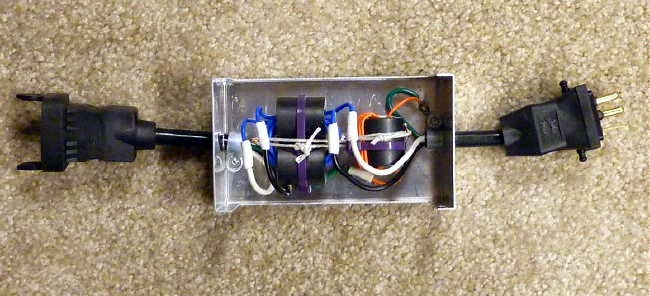 |
| Courtesy: http://tomthompson.com/radio/projects.html |
Another type of noise problem was addressed in a posting to the topband reflector today by Don, WD8DSB.....the noise coming from a treadmill's, PWM speed-controlled DC motor.
" For many years my wife's treadmill caused strong interference on 160 meters when it was in use, and yesterday I was able to completely eliminate the RFI using a combination of two different filters (a commercial line filter that provides both common mode and differential mode filtering, and 14
turns of the power cord on a 2.4" OD Fair-Rite #31 mix toroid core based on
the K9YC hams guide to RFI document).
I created a simple website that documents my tests and the filters used,
and for those interested the website URL is:
http://sites.google.com/site/treadmillrfi/
The website contains a link to a video on youtube where you can actually
see the effectiveness of the filters. "
These two amateurs have developed slick solutions to their noise problems, but sadly, noise ingression is rising exponentially it seems and is becoming more and more challenging to mediate.
 House Number Four
House Number Four
 It seems that if I'm not chasing down noisy power poles or hunting for drifting wireless headsets, both of which have tried their best to tax my 6m reception this past year, I spend several hours each year chasing down delinquent noise generators!
It seems that if I'm not chasing down noisy power poles or hunting for drifting wireless headsets, both of which have tried their best to tax my 6m reception this past year, I spend several hours each year chasing down delinquent noise generators! I spent yesterday afternoon searching the neighbourhood for the source of an annoying and disruptive 120Hz hum. Testing my patience for about a week now, the AC buzz has been ripping-into my usually quiet LF reception, disrupting efforts to participate in the latest CLE (189) listening event. Although conditions have been poor, as usually occurs during these events, the signal-shrouding AC hum has made the event a real struggle.
I had been hoping that, whatever the source of the suddenly-appearing interference was, it would disappear as quickly as it had arrived. I had first noticed it several weeks ago, but it would always go off around bedtime and often was not there at all in the evenings...but the past week it has been there 24/7.
Yesterday I had finally had enough and with Sony 2010 in hand, along with its built-in ferrite bar antenna, I tuned the radio to 630m and started walking around the neighbourhood.
The first thing I noticed was that the signal was being propagated along the overhead powerlines and it was difficult to get a direction of the true source...all nulls pointed to the closest line. Walking to the north, the signal gradually became weaker and reversing direction to the south produced an ever-increasing AC hum...progress! I eventually found a corner where the QRN peaked, and walking in all directions from that point saw the noise diminish...getting warmer!
There were four possible homes here that could be the cause of the problem. I spoke with three of the four homeowners, all of whom seemed genuinely concerned about the source. They all let me into their homes and, with radio in hand, look for the source of the (by now) loud buzz. None of the three homes seemed to furnish the nasty noisemaker.
House number four was unoccupied but was, I was told, up until about a week ago. Venturing on to the property, the S9 buzz started to climb and by the time I had reached the porch, the Sony was on the verge of self-implosion...getting very hot now! A knock on the door confirmed that nobody was home but...behind the curtain, there it was...a floor lamp was turned ON!!
With the source now located I could now breath a little easier but unfortunately could not hear any quieter. Hopefully the owners, who go back and forth to the mainland frequently, will return soon and that LF will once again sound as it should.
 What could be screwed into that floor lamp? I'm betting on a poor-quality or about-to-fail CFL bulb.
What could be screwed into that floor lamp? I'm betting on a poor-quality or about-to-fail CFL bulb. The one on the left is the actual bulb that I removed from a crawlspace, about four years ago, three houses away. It had been creating the same sort of buzz, only louder, as it was much closer. It was not emitting any light whatsoever yet continued to generate noise as well as present a real fire hazard. The house occupants had left it switched 'on' in order to discourage the local otter population from making a winter home in their crawlspace. Somewhere along the line the bulb had failed and started generating large amounts of AC hum.
This one was tough to find, as even several blocks away, it was very loud. It seems that power lines make wonderful LF antennas. I had to make a map showing signal strengths at many locations to find the source... my neighbours have since given me a key to their house, just in case it happens again!
So...what do you think is in house number four?
